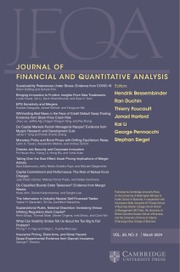No CrossRef data available.
Article contents
A Tale of Fear and Euphoria in the Stock Market
Published online by Cambridge University Press: 23 January 2025
Abstract
We propose a consumption-based model to explain puzzling unstable (i.e., sometimes positive and sometimes negative) relations between stock market variance with both stock market risk premia and prices. In the model, market risk premia depend positively (negatively) on fear (euphoria) variance. Market prices, which decrease with discount rates, correlate negatively (positively) with fear (euphoria) variance. Because it is the sum of fear and euphoria variances, the market variance may correlate positively or negatively with expected returns and prices, depending on the relative importance of the two variances. Our empirical results support the model’s key assumptions and many novel implications.
Information
- Type
- Research Article
- Information
- Creative Commons
- This is an Open Access article, distributed under the terms of the Creative Commons Attribution licence (http://creativecommons.org/licenses/by/4.0), which permits unrestricted re-use, distribution and reproduction, provided the original article is properly cited.
- Copyright
- © The Author(s), 2025. Published by Cambridge University Press on behalf of the Michael G. Foster School of Business, University of Washington
Footnotes
The paper formerly circulated under the titles “On the Stock Market Variance-Return or Price Relations: A Tale of Two Variances” and “On the Stock Market Variance-Return or Price Relations: A Tale of Fear and Euphoria.” We thank Thierry Foucault (the editor) and the anonymous referee for many insightful and constructive comments that greatly improve the exposition of the paper. We are grateful to Hengjie Ai, Gurdip Bakshi, Zhifeng Cai, Colin Campbell, Hung-Kun Chen, Jiakai Chen, Wen-I Chuang, John Crosby, Peter Easton, Mike Ferguson, David Hirshleifer, Victor Huang, Ye Li, Joon Ho Kim, Qianqiu Liu, Dimitris Papanikolaou, Ghon Rhee, Mehmet Saglam, Gill Segal, Ivan Shaliastovich, Tray Spilker, Chi-Yang Tsou, Harald Uhlig, Wenyu Wang, Ingrid Werner, Robert Whitelaw, Chen Xue, Shu Yan, Tong Yu, and seminar and conference participants at the University of Cincinnati, the University of Hawaii, National Taiwan University, Zhongnan University of Economics and Law, Dongbei University of Finance and Economics, the 2019 Midwest Finance Association Meeting, the 2019 American Finance Association PhD Student Poster Session, the 2020 Financial Management Association Meeting, the 2021 Frontiers of Factor Investing Conference, and the 2022 Midwest Economic Theory and International Trade Conference for comments and suggestions. We thank Dimitris Papanikolaou at Northwestern University for providing the industry classification data, David Ng at Cornell University for the implied cost of capital data, and Buhui Qiu at the University of Sydney for the average options-implied variance data.

